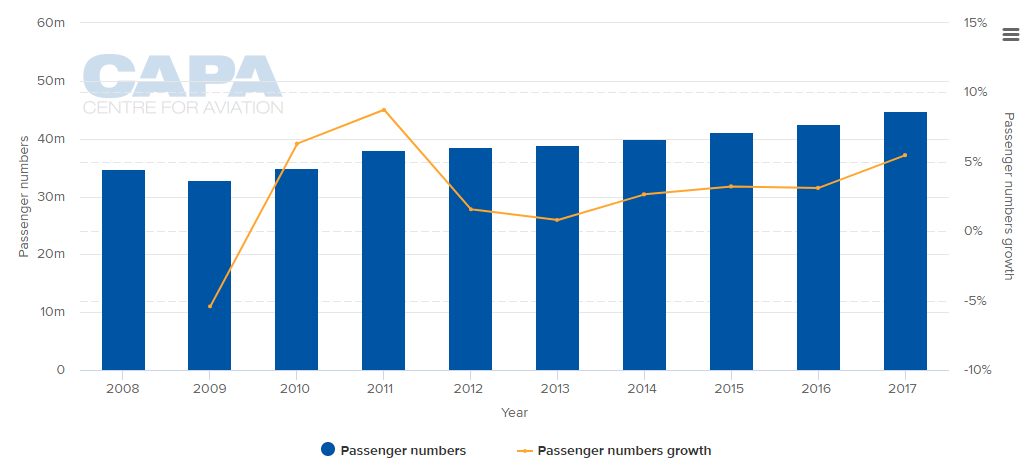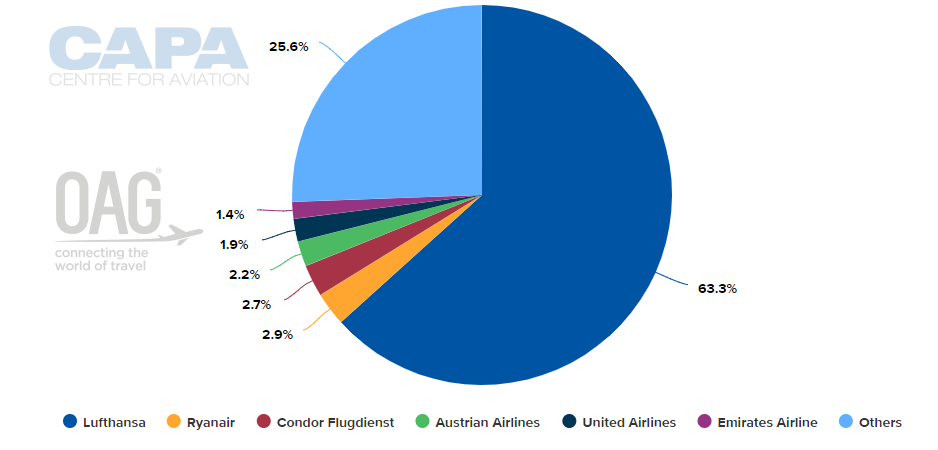Germany is not unique in developing a twin-hub city airport system - they exist in Spain and Italy - and there are other significant airports that are growing rapidly in the country. But Munich's growth from a regional Bavarian Airport to being the world's 37th busiest in 2016 is impressive. There has not been a single year since 2009 in which passenger traffic did not increase.
CHART - Munich Airport has seen regular growth in traffic levels throughout the current decade boosting passenger levels from 34.7 million in 2010 to over 44.5 million last year Source: CAPA - Centre for Aviation and Munich Airport reports
Source: CAPA - Centre for Aviation and Munich Airport reports
The difference in Munich's case compared to other countries is that Lufthansa's presence as measured by seat capacity is almost identical to that at Frankfurt.
Moreover, the expansion of Lufthansa's low-cost subsidiary Eurowings, by its positioning of medium and long-haul aircraft at Munich, one of its 10 operating bases, adds to Munich's competitiveness. While it has only 3.3% of seats at the moment, that will increase. Eurowings now has only two long-haul bases: Düsseldorf and Munich.
CHARTS - Lufthansa has a similar share of seat capacity at its hubs in Munich (top) and Frankfurt (bottom)
 Source: CAPA - Centre for Aviation and OAG (data: w/c 19-Feb-2018)
Source: CAPA - Centre for Aviation and OAG (data: w/c 19-Feb-2018)
Munich's third runway has come up across many obstacles since it was first proposed 11 years ago in 2007. Over 60,000 objections were filed, subsequently lawsuits, many of them on environmental grounds, though the result of a referendum against the runway was later overturned by the Bavarian Administrative Court.
In 2015, the airport received approval from Germany's Federal Administrative Court to build the runway. All appeals were dismissed and the 2014 decision of Bavaria's Higher Administrative Court to grant approval was upheld.
The runway will be a 4,000-metre (13,000 ft) construction, the same as the existing two, and probably to the northeast of the airport. But further impediments materialised in the form of the lack of unanimous approval by the three shareholders: the State of Bavaria, the Federal Republic of Germany and the City of Munich. The latter continues to oppose the plan.
On the other hand, the Bavarian Finance Minister appears at least tacitly to support the runway on the basis that without it there will only be moderate growth from 2020 and that would be a decisive factor in Bavaria maintaining its reputation as a business location. He is supported by over 200 businesses, representing DAX-listed companies through to SMEs.
The runway would increase movement capacity from 90 per hour to 120 per hour, but runway capacity is not so much the issue at Munich as terminal capacity. The older of the two terminals, T1, was identified for extensive renovations in mid-2016, in order to increase capacity by six million ppa, improve retail and catering offerings, and streamline passenger handling.
An extension to the recently opened (Apr-2016) satellite terminal is also under consideration. That terminal added capacity for a total of 11 million passengers per annum and boosted the overall capacity of Terminal 2 to 36 million.
CHART - More than three quarters of the capacity at Munich Airport is channelled through Terminal 2 Source: CAPA - Centre for Aviation and OAG
Source: CAPA - Centre for Aviation and OAG